Integrated strategy for real-time wind power fluctuation mitigation and energy storage system control
Yu Zhang,Yongkang Zhang,Tiezhou Wu
1. Hubei University of Technology,Hubei Key Laboratory of Solar Energy Efficient Utilization and Energy Storage Operation Control,Hubei,Wuhan 430068,P.R.China
Abstract: To address the impact of wind-power fluctuations on the stability of power systems,we propose a comprehensive approach that integrates multiple strategies and methods to enhance the efficiency and reliability of a system.First,we employ a strategy that restricts long-and short-term power output deviations to smoothen wind power fluctuations in real time.Second,we adopt the sliding window instantaneous complete ensemble empirical mode decomposition with adaptive noise (SW-ICEEMDAN) strategy to achieve real-time decomposition of the energy storage power,facilitating internal power distribution within the hybrid energy storage system.Finally,we introduce a rule-based multi-fuzzy control strategy for the secondary adjustment of the initial power allocation commands for different energy storage components.Through simulation validation,we demonstrate that the proposed comprehensive control strategy can smoothen wind power fluctuations in real time and decompose energy storage power.Compared with traditional empirical mode decomposition (EMD),ensemble empirical mode decomposition (EEMD),and complete ensemble empirical mode decomposition with adaptive noise(CEEMDAN) decomposition strategies,the configuration of the energy storage system under the SW-ICEEMDAN control strategy is more optimal.Additionally,the state-of-charge of energy storage components fluctuates within a reasonable range,enhancing the stability of the power system and ensuring the secure operation of the energy storage system.
Keywords: SW-ICEEMDAN;HESS;Real-time smoothing;Rule-based multi-fuzzy control;SoC
0 Introduction
In recent years,a growing societal emphasis has been placed on new energy generation [1-4].In this context,wind power generation,as a form of clean energy,has garnered extensive attention and witnessed significant large-scale development.However,wind power generation faces a notable challenge in the form of power fluctuations,which hinder its seamless integration into the power grid.To address this challenge effectively,energy storage technologies have been introduced to mitigate the volatility of wind power [5-6].
Power-based energy storage technologies,such as supercapacitors and flywheels,are capable of rapid response and high-power output.They effectively stabilize the instantaneous load fluctuations of a power system,thus maintaining frequency stability [7-8].Energy-based storage technologies,including lithium-ion batteries and fuel cells,focus on prolonged energy storage and discharge,making them suitable for storing renewable energy and managing day-night load variations [9-10].The combination of these two types of energy storage components provides synergistic advantages.The resulting hybrid energy storage systems enhance the stability and reliability of power systems,optimize energy utilization efficiency,and provide robust support for the development of sustainable energy[11-12].
In both domestic and international literature,extensive progress has been made regarding strategies for mitigating wind power fluctuations using hybrid energy storage systems.Long [13] proposed the use of wavelet decomposition theory to break down the original output power of a wind farm into multiple scales and employed fuzzy control to optimize the initial power allocation of the hybrid energy storage system.However,the choice of the wavelet decomposition layers affects the decomposition results.Xianjun and Jia [14-15] introduced an improved wavelet packet suppression strategy that not only meets wind power grid connection standards,but also reduces the charge-discharge switching frequency,thereby enhancing the economic viability of the storage system.Zhang [16]proposed sliding averaging and EMD to obtain gridconnected and energy storage power signals with the goal of maximizing the net benefits to complete the energy storage system configuration.Guo [17] proposed the use of EEMD to decompose hybrid energy system power by considering the state-of-charge (SoC) and configuring the rated power and capacity.Using the adaptive variational mode decomposition (VMD) algorithm,Xiao [18] adaptively decomposed wind power by incorporating the states of supercapacitors and hydrogen storage tanks to allocate internal power.Fang [19] employed VMD and the Wigner–Ville distribution algorithm to process original power data and applied the chaos particle swarm optimization algorithm to address two-stage monthly and day-ahead optimization problems.Xidong [20] presented a method that combines optimal exponential smoothing with CEEMDAN to obtain grid-connected and stored power,thereby facilitating internal power allocation within the energy storage system.
Multiscale decomposition strategies,such as wavelet decomposition,EMD,and VMD,effectively break down wind-power fluctuations into components of different frequency scales.Coupled with various energy storage elements,these strategies facilitate multiple energy storage combinations and optimize the efficiency of energy storage systems [21].However,strategies such as wavelet decomposition and VMD require suitable parameter selection [22],introducing subjectivity that may affect the decomposition quality.Additionally,multiscale decomposition relies heavily on historical data,which affects its real-time applicability.
In the aforementioned study,we employed multiscale decomposition strategies such as wavelet decomposition,EMD,and VMD to effectively decompose the fluctuation of the wind power output into components of different frequency scales.We successfully achieved smooth regulation of wind power fluctuations by integrating various types of energy storage elements.However,these control strategies are limited because they cannot decompose data at a specific moment and can only analyze power signals within specific time intervals.Currently,addressing this problem primarily relies on methods such as power prediction and planning for grid-connected power,which constrain the real-time control of wind power output integration and power allocation in hybrid energy storage systems.Additionally,owing to the fixed capacity configuration of energy storage elements,improper internal power allocation in energy storage systems may lead to the overcharging and overdischarging of storage components,consequently reducing the overall lifespan of the energy storage system.
Considering the existing challenges for the grid integration control of wind power output,we propose a method that restricts long-and short-term power output deviations to effectively smoothen fluctuations in wind power in real time.In terms of power allocation in hybrid energy storage systems,we employed the SW-ICEEMDAN control strategy for the real-time decomposition of the energy storage power.To address the overcharging and overdischarging of energy storage components,we introduce a rule-based multi-fuzzy control strategy for the secondary adjustment of the initial power allocation.The conceptual framework is illustrated in Fig.1.Through this comprehensive strategy,we achieved coordinated operation between the power and energy storage systems,ensuring the safety and stability of the overall system.
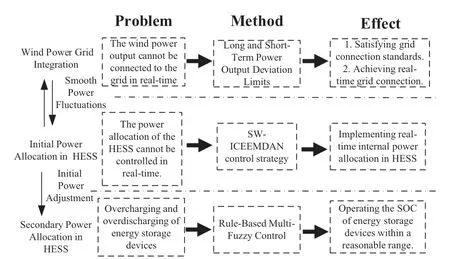
Fig.1 Overall conceptual framework diagram
1 Wind-Energy Storage System Architecture
The wind storage system is composed of a wind farm,hybrid energy storage system,power grid,and loads [23].Its structure is illustrated in Fig.2.Hybrid energy storage systems consist of supercapacitors and lithium batteries.In the diagram,PW(t) represents the power output of the wind farm,PG(t) represents the power obtained from the electrical grid,andPHESS(t) represents the charging and discharging power of the hybrid energy storage system.The wind farm is connected to the DC bus via an AC/DC converter,and the hybrid energy storage system is connected to the DC bus through a DC/DC converter.PB(t) represents the battery power absorption/output at timet,andPSC(t) represents the power absorption/output of the supercapacitor at timet.These relationships can be expressed as follows∶
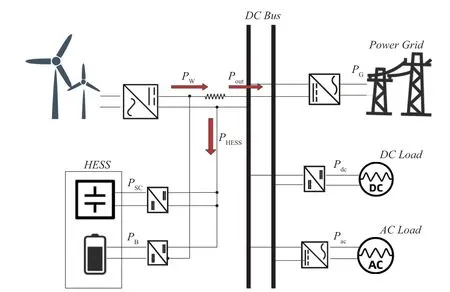
Fig.2 Architecture of wind farm and energy storage system
This integrated configuration facilitates the effective utilization of wind energy,coupled with the capabilities of hybrid energy storage components,grid connectivity,and power exchange mechanisms.This ensures the stability and reliability of the power grid.The subsequent sections elaborate on the specific strategies and techniques that optimize the performance of this intricate architecture,thereby enhancing its practical applicability and effectiveness.
2 Grid Integration Strategy Based on Long and Short-Term Power Output Deviation Limits
2.1 Active Power Grid Integration Standards
To mitigate the substantial fluctuations in the active power injected into the grid,national standards have been established to define the maximum permissible variations in the active power output of wind farms under normal operational conditions [24].These standards encompass various time scales.The prescribed limits for changes in the active power output of wind farms connected to the grid under typical operating conditions are listed in Table 1.
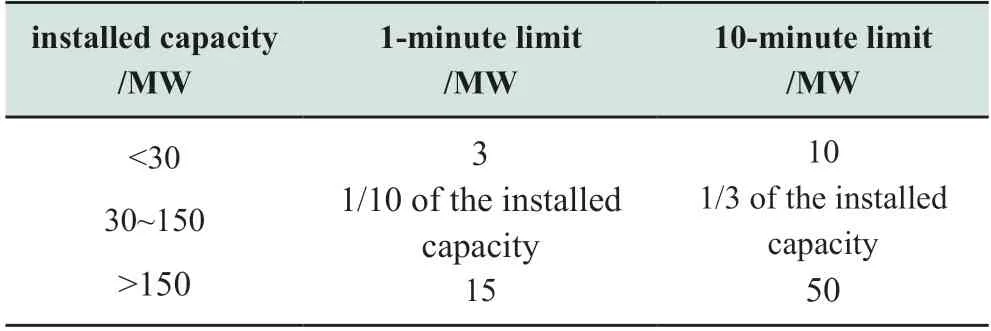
Table 1 Maximum limit of wind farm active power change
2.2 Short-Term Power Output Deviation Limit:
By comparing the input power with the maximum and minimum values of the output power within the last minuteif the difference between the two is less thanλ1,the outputremains unchanged.Otherwise,the outputis adjusted accordingly.Thus,the calculation of the output is based on the input power,andλ1.This ensures that the 1-minute grid-connected power fluctuates within the allowed range of wind power fluctuations,following the processing formula (2)∶
2.3 Long-Term Power Output Deviation Limit:
To date,only short-term limitations have been addressed.Therefore,addressing these long-term limitations is necessary.This process occurred over the past 10 min.The maximum and minimum values of the output power over the last 10 min (and) are calculated using statistically sampled data.These values are compared withand the same approach as that for short-term power processing is applied.Building upon the determination of 1-minute compliance with grid standards,the 10-minute grid-connected power can fluctuate within the permissible range of wind power fluctuations,following the processing formula (3)∶
wherePoutdenotes the grid-connected power.is the minimum value within a 10-minute sliding window.λ10is the limit of power fluctuation within 10 min.is the maximum value within a 10-minute sliding window.
This approach ensures that both short-and longterm fluctuations in grid-connected power adhere to the prescribed standards,effectively managing the impact of wind power fluctuations on the stability and reliability of the power system.
Fig.3 illustrates the workflow for determining the gridconnected power.To address the short-term limitations,the values ofλ1,,andare established in the first stage.Here,the value ofλ1is set based on grid fluctuation constraints,while values ofandare allocated based on the output power.Once these parameters are determined,the value ofis calculated.Subsequently,in the second stage,values ofλ10,andare established,and the operations for long-term limitations are performed.
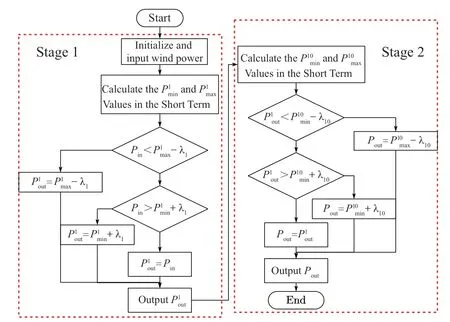
Fig.3 Flowchart of grid-connected power determination
The process delineated in Fig.3 outlines the sequential steps involved in ensuring that the grid-connected power adheres to both short-and long-term limitations.By consecutively setting and calculating the relevant parameters,the approach effectively manages power fluctuations and aligns them with the stability and reliability requirements of the power system.
3 Power Allocation and Capacity Pre-Configuration in HESS
Traditional signal decomposition methods face challenges in dealing with the real-time processing of energy storage power signals.To overcome this problem,a control strategy that combines conventional decomposition algorithms with a sliding window approach is introduced.Specifically,by shifting the sliding time window,the raw wind power signal within the time window is decomposed into intrinsic mode functions (IMFs) in different frequency ranges.This enables the precise control and monitoring of energy storage systems while fulfilling real-time requirements.
3.1 ICEEMDAN Decomposition Strategy
The traditional ICEEMDAN decomposition strategy reduces mode mixing,enhances the decomposition accuracy,and accurately describes the spectral characteristics of wind power.It possesses the capability of adaptively adjusting the number of decomposition layers,enabling flexible decomposition based on the characteristics of the actual signal,and thus better capturing the fluctuation characteristics of wind power.The specific decomposition steps based on ICEEMDAN are as follows∶
(1) Introduce into the original signalx∶
wherex={xj,j=1,2,…,L} is the original signal,is the j-th IMF component obtained by EMD with added Gaussian noise,(i=1,2,…,L) representing the i-th added Gaussian noise component,andxirepresents the new signal obtained after adding Gaussian noise.β0is the standard deviation of the Gaussian noise,std(·) and is the standard deviation operator.
(2) Calculate the sum of the local means ofxiand consider its mean as the first residual component.
whereM(xi) represents the local mean of the i-th decomposed signal,andM(·) represents the local mean operator.Thus,the first IMF component is given byc1=x-r1.
(3) Analogously,other components of IMF are derived ascm=rm-1-rm,where m>1.
In the ICEEMDAN control strategy,the noise amplitude A is assigned a constant value.However,the ICEEMDAN strategy is sensitive to the parameter selection.To address this problem,after adding random white noise,the signal-to-noise ratio (SNR) is determined using the following formula [25]∶
The amplitude value for each data point was subsequently derived from equation (9),as follows∶
Obtain the mean amplitude for each moment,and for different moments,the maximum value from this set of means is used as the noise amplitude in ICEEMDAN.
3.2 SW-ICEEMDAN Decomposition Strategy
Although the ICEEMDAN strategy performs well in decomposing wind power signals,it lacks real-time processing capabilities for individual power signal points.To address this problem,the SW-ICEEMDAN strategy is proposed,which decomposes the power signal at a fixed timescale K.The SW-ICEEMDAN decomposition control strategy principle is depicted in Fig.4.
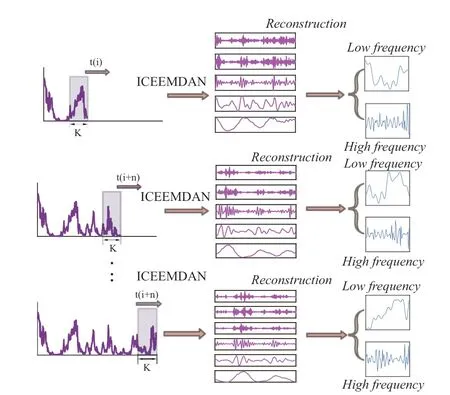
Fig.4 Sliding Window Principle Diagram
The sliding window method is a time-series analysis approach that involves moving a fixed-size window along the time series,processing and analyzing the data within the window,and continually outputting the result sequence.This approach facilitates flexible decomposition,allowing for a better capture of the fluctuation characteristics of wind power.
Specific steps are outlined as follows∶
1.Set the sliding window sizeKand step lengthS.
2.ICEEMDAN Processing and Analysis∶ Within each sliding window,ICEEMDAN was applied to the original wind power signal,resulting in low-and high-frequency power signals.
3.The decomposed IMFs are reconstructed based on the principle of minimizing mode mixing between adjacent IMFs.
4.From the reconstructed power signals,the power value at the last time step was selected and allocated to the energy storage components.
5.Utilizing the new power data,the above steps are iterated and the allocation strategy for the energy storage components is continuously adjusted.
These steps constitute a comprehensive approach for managing power allocation within the hybrid energy storage system.By incorporating ICEEMDAN and the sliding window technique,the methodology ensures realtime adaptability while efficiently controlling the power fluctuations.
3.3 Capacity Pre-Configuration in HESS
Based on historical wind power fluctuation data for different quarters,we utilized decomposition algorithms to decompose the original wind-power output.The capacity of the HESS was preconfigured to determine the rated power and capacity of the energy storage components.The actual compensating power formula for the energy storage components,considering energy efficiency,is represented by Equation (12).
By taking the maximum and minimum values of the cumulative capacity,the rated capacity of the supercapacitor was calculated using Equation (14).
SoCminrepresents the lower limit of the SoC allowable range for the energy storage component,SoCmaxrepresents the upper limit of the SoC allowable range.T represents the time period of the power imbalance,and Δtrepresents the sampling duration.
Similarly,the rated powerPBand rated capacityEBof the battery can be obtained by utilizing power allocation for lithium-ion batteries.
4 Power Secondary Allocation Strategy Based on Rule-Based Multi-Fuzzy Control
Within the hybrid energy storage system,the initial power allocation is determined based on the frequency characteristics of the battery and the principle of minimizing mode mixing.However,this method does not fully consider the SoC of the battery during actual operation,which may have adverse effects on the lifespan of an energy storage system.Therefore,a rule-based multi-fuzzy control strategy was employed for the secondary adjustment of power allocation within the energy storage system.This improved strategy not only enhances the precision and reliability of the power allocation aspect of the system,but also contributes to the overall performance and long-term sustainability of energy storage system.
Fuzzy controllers are highly sensitive to variations in uncertainty factors,and their performance is influenced by a multitude of fuzzy rules and membership functions.The configuration of these parameters necessitates the consideration of various factors,such as system dynamics and environmental changes.Consequently,debugging may pose challenges during the tuning process,leading to insufficient reliability of the control effects.To address the robustness and reliability issues in a single fuzzy controller,we propose a rule-based multi-fuzzy control strategy.This strategy overcomes the limitations of a singular fuzzy controller,thereby enhancing the robustness and reliability of the control system.
FuzzySCand FuzzyBserve as multi-fuzzy controllers,each comprising three distinct fuzzy controllers,denoted as Fuzzy Control 1,Fuzzy Control 2,and Fuzzy Control 3,as shown in Fig.5.These three fuzzy controllers share identical fuzzy control rules,The fuzzy control rules are as shown in Table 2.while employing distinct membership functions.

Table 2 Rule of fuzzy controler

Fig.5 rule-based multi-fuzzy control schematic
Input∶ SoC,with a fundamental domain of [0,1],and fuzzy sets {VS,S,MS,M,MB,B,VB};
Input∶ Change in SoC (ΔSoC),with a fundamental domain of [−1,1],and fuzzy sets {NB,NM,NS,PS,PM,PB};
Output∶ with a fundamental domain of [0,1],and fuzzy sets {VS,S,M,MS,MB,B,VB}.
Finally,the center-of-gravity method is employed to defuzzify the fuzzy outputs and obtain the values ofKscandKb.
When using membership functions with high slopes in a fuzzy controller,even slight variations in the input variables can result in rapid output changes.Conversely,when the membership functions have gentler slopes,significant changes in the input variables are required to affect the output noticeably.Based on this characteristic of fuzzy control,we adopted a combined approach of multi-fuzzy and rule-based control.This involves employing fuzzy controllers with different slopes for different SoC ranges,as shown in Fig.6.The objective of this strategy is to fully leverage the advantages of different membership function slopes,thereby enabling a more precise and adaptable form of control.
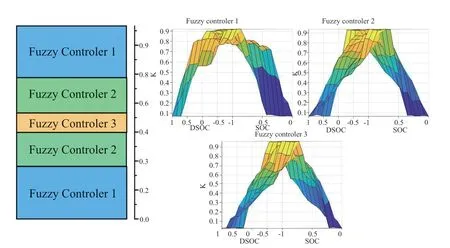
Fig.6 Range of Distribution Intervals for Fuzzy Controller
Three fuzzy controllers were employed,each with distinct slopes.Fuzzy Controller 1 exhibits the steepest slope,followed by Fuzzy Controllers 2 and 3 with the gentlest slope.
If SoC ∈ [b c],Fuzzy Controller 3 is utilized.
If SoC ∈ [a b] or SoC ∈ [c d],Fuzzy Controller 2 is employed.
If SoC ∈ [d1] or SoC ∈ [0a],Fuzzy Controller 1 is used.The modification principles for the initial allocation power command of energy storage components are as follows∶
1.When the SoC of the energy storage component remains within a reasonable range,the supercapacitor executes the initial allocation power command as instructed.
2.If the SoC of the energy storage component is relatively low and ΔSoC is less than zero,or if the SoC is relatively high and ΔSoC is greater than zero,the power adjustment coefficientkis tuned.
The modified power command for the supercapacitor is given by equation (9).
The difference in ΔPSCbetween the power commands before and after the supercapacitor power command modification was compensated for by the lithium-ion battery.Following the same modification principles as those applied to the supercapacitor,FuzzySCoptimizes the power of a lithium-ion battery.The adjusted power command for the lithium-ion battery is then determined.
5 Results and discussion
Based on a year’s worth of data from a 158 MW wind farm in a specific region,with a sampling interval of 1 min,the collected raw wind power data were subjected to K-means clustering to extract the characteristic power outputs for four distinct seasons.Real-time processing of wind power,denoted asPW(t),was carried out in accordance with the national grid fluctuation standards.According to grid power standards,fluctuations in grid power over a 1-minute period must not exceed 15 MW,and fluctuations over a 10-minute period must remain below 50 MW.Following optimization using strategies to limit deviations in both the short-and long-term power outputs,the resultant grid-connected power was obtained,as illustrated in Fig.7.

Fig.7 Power smooth before and after comparison
From Fig.7,it is evident that the grid-connected power,shaped by the long-and short-term power deviation limiting strategies,exhibits a notably smoother profile when compared with the original power profiles for the four seasons∶ spring,summer,autumn,and winter.To assess whether the grid-connected power fulfills the requirements for grid connection,the deviations of the grid-connected power over 1/10-minute intervals were computed.The results are shown in Fig.8.
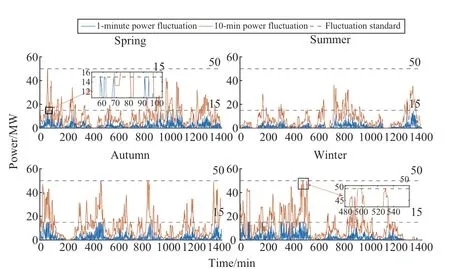
Fig.8 1/10-minute grid-connected power fluctuation
As evident from Fig.8,after undergoing processing,the original wind power signal results in power values over 1/10-minute intervals that are consistently below the grid fluctuation thresholds of 15/50 MW,thus adhering to the national grid connection standards.This demonstrates the effectiveness of long-and short-term power deviation limiting strategies in reducing fluctuations,thereby mitigating the impacts on the power grid system and enhancing grid stability.Following the processing of the raw wind power signal,grid-connected power and energy storage power that complied with the grid connection standards were obtained.
To ensure the real-time allocation of energy storage power to hybrid energy storage components with distinct frequency response characteristics,the SW-ICEEMDAN technique was employed.Considering a spring as an example,with a sliding window length ofK=1200 and strideS=1,the energy storage power is decomposed into highand low-frequency components using the SW-ICEEMDAN approach at time instancest=1,t=100,andt=200,as illustrated in Fig.9.

Fig.9 Result of SW-ICEEMDAN decomposition
Fig.9 illustrates the gradual reduction in fluctuations from the first intrinsic mode function (IMF) to the last IMF,ultimately reaching a stable pattern.
To mitigate the interference of modal mixing among power signals on the energy storage components,the Pearson correlation coefficient was used to quantify the correlations between adjacent IMFs.This correlation analysis serves as the basis for the initial allocation of the energy storage power between supercapacitors and lithiumion batteries.The calculated results depicting the Pearson correlation coefficients between neighboring independent components for the energy storage power are shown in Fig.10.

Fig.10 Correlation coefficients between adjacent IMFs
In Fig.10,whent=1,the minimum correlation coefficient at decomposition point 6 is 1.69%,which implies that the power values reconstructed from IMF1 to IMF6 at the last time step are allocated to the supercapacitors,and the power value of IMF7 at the last time step is allocated to lithium-ion batteries.Similarly,att=100,the power allocation to supercapacitors and lithium-ion batteries involves IMF1 to IMF5 and IMF6 to IMF8;att=200,it involves IMF1 to IMF5,and IMF6 to IMF9.
Based on the new power data,a continuous time evolution was utilized for ongoing monitoring and response to wind-power fluctuations.Ultimately,the power allocation results within the energy storage system for a duration of 1440 minutes were obtained,as depicted in Fig.9.
Fig.11 vividly demonstrates the extreme volatility in the power allocation of supercapacitors,highlighting their ability to rapidly respond and discharge energy.In contrast,the power allocation for lithium-ion batteries exhibits relatively stable behavior,showing more consistent characteristics.
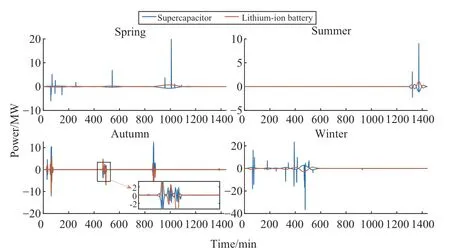
Fig.11 Energy storage system power curve
A comprehensive analysis leads to the conclusion that the SW-ICEEMDAN strategies effectively decompose energy storage power in real-time scenarios.This approach aligns with the performance attributes of different energy storage components,allowing them to fully leverage their advantages.
Different control strategies have a significant impact on the configuration of the energy storage components.When decomposition strategies are employed,the occurrence of severe modal aliasing phenomena can introduce errors in the reconstructed power,consequently influencing the capacity allocation of the energy storage components.This,in turn,may lead to unnecessary costs and waste of resources.Therefore,when selecting an appropriate control strategy,it is essential to comprehensively consider the influence of modal aliasing on system performance,as well as the costs and resource consumption associated with the configuration of energy storage components.
By utilizing different decomposition strategies,including EMD,EEMD,and CEEMDAN,the energy storage power can be adaptively decomposed.This enabled us to determine the requisite capacity configurations for the energy storage components across various control strategies.The specific configurations are listed in Table 3.

Table 3 Energy storage component configuration with different control strategies
The required capacity configuration was determined by separately calculating the combined capacities of the supercapacitors and lithium-ion batteries for each of the four seasons∶ spring,summer,autumn,and winter.The maximum value among these calculated capacities was selected.Table 3 indicates that under the SW-ICEEMDAN control strategy,the required capacity configuration is 5.12 MW·h.In this scenario,the corresponding lithium-ion battery capacity is 3.41 MW·h,the capacity configuration for supercapacitors is 1.71 MW·h.Compared to the other three control strategies,the SW-ICEEMDAN control strategy exhibits the most economical and efficient capacity configuration,notably surpassing the EMD,EEMD,and CEEMDAN control strategies.This further underscores the superiority of the SW-ICEEMDAN as an efficient control method,aiding in the reduction of costs and resource consumption associated with the energy storage component configuration of the system.
The initial power allocation to the energy storage system was performed.A comparison of the SoC variation curves of the energy storage component before and after power optimization using rule-based multifuzzy control is illustrated in Fig.11 and Fig.12.The threshold values for the rule-based fuzzy control were set toa=0.35,b=0.45,c=0.55,andd=0.65.
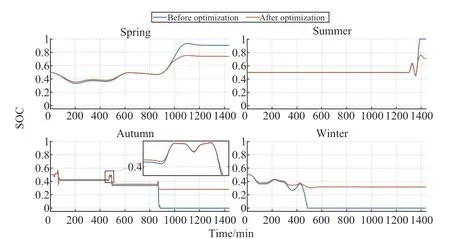
Fig.12 SoC change curve of lithium battery
To ensure the safe operation of lithium-ion batteries,it is essential to maintain their SoC within a specific range,generally between [0.2,0.8].As illustrated in Fig.12,without optimization,the SoC of the lithium-ion battery exhibits significant fluctuations,surpassing the safety range during all seasons.However,after optimization,the SoC of the lithium-ion battery was consistently maintained within a safe range.This optimization measure significantly mitigates the risks of overcharging and overdischarging of the lithium-ion battery,effectively reducing the duration during which the battery remains in these unsafe states.
To ensure the safe operation of supercapacitors,it is imperative to maintain their SoC within a specific range,generally operating within the SoC range of [0.1,0.9].As shown in Fig.13,without optimization,the SoC curves for spring,summer,and autumn fell below the lower limit,whereas the SoC curve for winter exceeded the upper limit.However,following optimization through rule-based multifuzzy control,the SoC curves for all seasons remained consistently within a safe range.
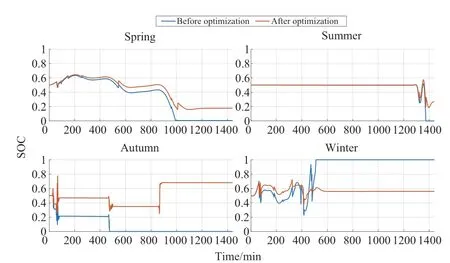
Fig.13 SoC change curve of supercapacitor
By employing a rule-based multi-fuzzy control strategy for power optimization,significant enhancements in the SoC variation of the energy storage components were achieved.This stability enables them to remain within a safe operational range,thereby enhancing the safety and stability of energy storage system.
6 Conclusion
1) Real-time control strategies based on short-and longterm power deviations have been implemented to smoothen wind power fluctuations,ensuring that power fluctuations during different time periods remain within the requirements of the grid connection.This enhancement improved the stability,reliability,and efficiency of the system.
2) The implementation of the SW-ICEEMDAN control strategy enables real-time power allocation among the internal components of the energy storage system.This enables the energy storage elements to share power fluctuations reasonably,contributing to a reduction in costs and resource consumption associated with the configuration of the system’s energy storage components.
3) A rule-based multi-fuzzy control strategy was employed to optimize the initial power allocation commands for the energy storage components.This ensures that the SoC of the energy storage components remains within a reasonable range,thus guaranteeing the safe and stable operation of the energy storage system.Consequently,the lifespan of the energy storage components is effectively prolonged.
Acknowledgements
This study was supported by the National Natural Science Foundation of China (Grant No.51677058).
Declaration of competing interest
We declare that we have no conflict of interest.
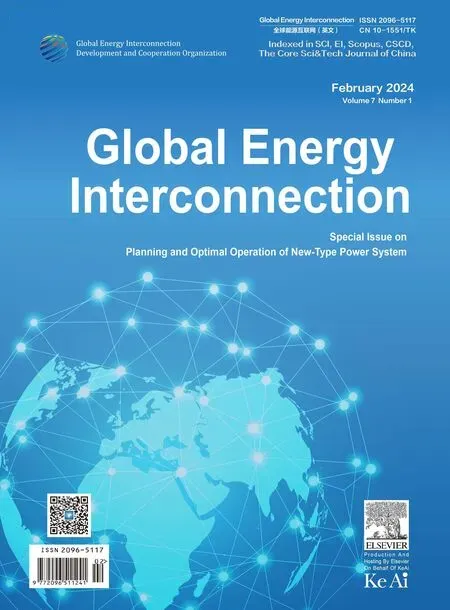 Global Energy Interconnection2024年1期
Global Energy Interconnection2024年1期
- Global Energy Interconnection的其它文章
- Double-ring high-frequency common-mode switching oscillation current sensor for inverter-fed machine winding insulation monitoring
- Multi-source heterogeneous data access management framework and key technologies for electric power Internet of Things
- A digital twin model-based approach to cost optimization of residential community microgrids
- Optimal operation of Internet Data Center with PV and energy storage type of UPS clusters
- Optimal scheduling of a township integrated-energy system using the adjustable heat-electricity ratio model
- Optimal dispatching strategy for residential demand response considering load participation
